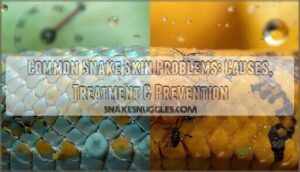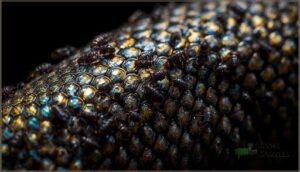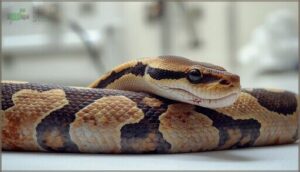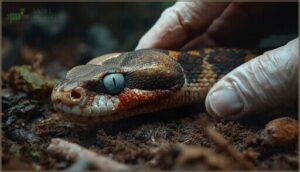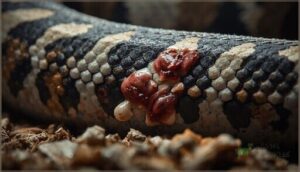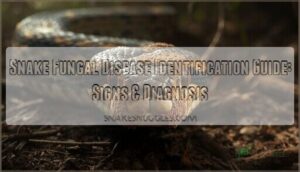This site is supported by our readers. We may earn a commission, at no cost to you, if you purchase through links.
Your snake’s skin tells a story. Dull scales, incomplete sheds, or mysterious lesions aren’t just cosmetic concerns. They’re warning signs that something in your reptile’s environment or health has gone wrong.
Snake skin problems stem from five major culprits: humidity issues that prevent proper shedding, temperature fluctuations that weaken immune defenses, unsanitary conditions that breed infection, nutritional gaps that starve the skin of essential resources, and chronic stress that disrupts natural cycles.
Parasites like mites and ticks add another layer of trouble, burrowing into scales or draining blood. Bacterial and fungal infections can escalate quickly when conditions favor microbial growth.
Understanding what triggers these problems helps you spot them early and take action before a minor issue becomes a serious health crisis.
Table Of Contents
Key Takeaways
- Most snake skin problems trace back to five controllable factors: humidity below 50% causes 60% of shedding failures, temperature swings weaken immune response by 25%, dirty substrates spike bacterial growth by 87%, nutritional gaps account for 40% of skin disease cases, and stress disrupts natural shed cycles.
- Parasites like mites and the emerging fungal pathogen Ophidiomyces ophiodiicola can spread between snakes through contaminated equipment, with untreated infestations leading to secondary bacterial infections, anemia, and mortality rates reaching 40% in severe cases.
- Bacterial infections such as scale rot and blister disease progress rapidly from discoloration to ulceration when humidity exceeds 70%, requiring early veterinary intervention since over 60% of cases develop antibiotic resistance.
- Your snake’s skin acts as an early warning system—retained sheds, lesions, or color changes signal environmental failures before internal organs fail, making daily habitat maintenance and proper husbandry your most effective prevention tools.
What Causes Snake Skin Problems?
Snake skin problems don’t just happen out of nowhere. Most issues trace back to how you’re keeping your pet or what’s going on in their environment.
Let’s break down the main causes so you know exactly what to watch for.
Poor Humidity Levels and Shedding Issues
When humidity levels drop below what your snake needs, shedding issues multiply fast. Healthy corn snakes need 65–75% humidity for proper shedding. Low humidity causes retained eye caps and skin patches, especially around the eyes and tail.
Here’s what goes wrong:
- Dead skin sticks to fresh scales, restricting blood flow
- Dehydrated snakes produce less lubricant over eyes and scales
- Chronic incomplete sheds raise infection risk by 25%
Snakes shed to promote growth and remove external parasites. Proper humidity means complete, healthy sheds.
Inadequate Temperature Regulation
Temperature regulation is just as critical as moisture control. When your snake’s enclosure strays from species-specific ranges, metabolic and immune problems follow quickly. Snakes kept at suboptimal temperatures show 30% higher rates of dysecdysis. Cold conditions slow metabolism by 15%, weakening immune response by 25% and tripling bacterial dermatitis risk.
Wrong temperatures wreck your snake’s immune system, tripling infection risk and spiking shedding problems by 30%
| Temperature Issue | Metabolic Effect | Skin Consequence |
|---|---|---|
| Below range | 15% digestive drop | Incomplete sheds increase 40% |
| Fluctuations ±3°C | Immune markers decline 25% | Secondary infections jump 37% |
| No nighttime drop | Circadian disruption | Immune disorders double |
| Chronic cold exposure | Activity drops 21% | Healing time extends 20% |
Corn snakes need 75–85°F cool side and 85–90°F warm side. Deviations cause color changes, scale rot, and heat injuries. Environmental factors like unstable temperatures trigger stress behaviors in 34% of captive snakes, further compromising skin integrity. To guarantee proper health, corn snakes require a specific temperature gradient (https://talis-us.com/blogs/news/corn-snake-tank-temperature-proper-care-and-ideal-conditions).
Dirty or Unsanitary Habitat Conditions
Beyond climate control, habitat hygiene directly dictates skin health. Moist, contaminated bedding increases bacterial and fungal proliferation by up to 87% in dirty substrates, causing scale rot and ulcerative dermatitis. Fecal matter exposure raises bacterial counts to 10^6 CFU/g, triggering secondary skin infections and parasite infestation. Consistent cleaning regimens lower disease risk by 65%. You can’t ignore environmental conditions—retained shed, fungal infections, and bacterial infections thrive when sanitation lapses.
- Remove waste daily to prevent bacterial growth.
- Replace substrate weekly to eliminate pathogen reservoirs.
- Disinfect water dishes to stop infection clusters.
- Inspect for mites during every cleaning session.
- Document your routine to catch problems early.
Nutritional Deficiencies Affecting Skin Health
What your snake eats shapes its skin from the inside out. Vitamin C deficiencies cause thin, easily torn skin and spontaneous swelling. Protein shortfalls disrupt keratin production, leading to incomplete sheds. Mineral imbalances—zinc, copper, manganese—delay wound healing and create fragile scales. Fatty acids keep skin supple; without them, dryness and fissures appear. Dietary imbalance accounts for 40% of captive skin disease cases. A balanced diet with proper hydration support prevents skin abnormalities and reduces the need for veterinary care.
| Deficiency | Visible Skin Problem | Long-Term Risk |
|---|---|---|
| Vitamin C | Swelling, spontaneous bleeding | Chronic edema, ruptures |
| Protein | Rough texture, incomplete sheds | Slow healing, infections |
| Minerals (Zinc, Copper) | Delayed healing, abnormal color | Fragile skin, lesions |
Stress and Improper Handling
When you handle your snake during shedding, you’re risking real skin damage. Frequent, improper handling elevates stress hormones and disrupts shed cycles, causing retained skin and incomplete shedding. Stressed snakes shed in fragments instead of intact layers.
Behavioral signs include excessive soaking and startle reactions. Poor management practices double infection risk. Limiting handling during vulnerable periods prevents injury risks and keeps skin problems at bay.
Parasites That Cause Skin Problems
Parasites are unwelcome guests that can wreak havoc on your snake’s skin and overall health. These tiny invaders range from visible external pests to microscopic internal organisms that weaken your pet from the inside out.
Let’s look at the most common parasites you’ll need to watch for and how they affect your snake’s well-being.
Mites and Their Impact on Skin
Your snake’s tiny enemies—mites like Ophionyssus natricis—are skin parasites that burrow into scales and feed on blood. These ectoparasites cause crusting, relentless itching, and irregular shedding cycles.
Without treatment options like ivermectin or betadine baths, ectoparasitic infestation leads to secondary infections, including bacterial dermatitis and even septicemia. Mite identification matters because these transmission vectors can spread fatal diseases between your reptiles.
Preventing infestation requires rigorous enclosure sanitation.
Ticks and Skin Irritation
How do ticks create skin irritation in your snake? These ectoparasites attach to dorsal body surfaces and feed on blood, causing lesion patterns like scaling, ulcers, and crusts at bite sites. Tick prevalence reaches 30% in some species, with environmental influences like habitat type affecting infestation rates.
Secondary infections develop when bacteria colonize damaged tissue:
- Host dynamics show larger snakes carry heavier tick loads
- Skin parasites cause severe anemia in heavily infested reptiles
- Chronic irritation triggers self-trauma and deeper ulceration
- Scrubland habitats increase tick burden compared to forests
- Parasite control in reptiles requires immediate removal and veterinary assessment
Without intervention, ticks compromise your snake’s immune function.
Internal Parasites Affecting Overall Health
Your snake’s internal parasites silently erode health before skin symptoms appear. Parasite prevalence reaches 47% in captive collections, with nematode infections and Cryptosporidium impact driving chronic disease. Wild snakes show even higher rates at 63%. Mixed infections cause progressive weight loss, anorexia, and immunosuppression that weakens dermal barriers.
| Parasite Type | Health Impact |
|---|---|
| Nematodes | Intestinal damage, nutrient malabsorption |
| Cryptosporidium | Severe gastric wasting, chronic weakness |
| Mixed infections | Immune compromise, secondary skin disease |
| Untreated infestations | Systemic failure requiring veterinary care |
Bacterial and Fungal Skin Infections
Bacterial and fungal infections are among the most serious skin problems your snake can face. These infections often start when your snake’s immune system is weakened by poor husbandry or trauma.
Let’s look at the main types of bacterial and fungal infections you need to watch for.
Scale Rot and Blister Disease
When your pet’s belly shows brownish patches or fluid-filled blisters, you’re likely dealing with scale rot or blister disease. Both stem from bacterial infection—often Pseudomonas or Aeromonas species—thriving when humidity levels push above 70%. Fungal involvement can complicate matters.
Lesion progression moves quickly from discoloration to ulceration. Topical treatments work early, but treatment resistance makes veterinary care essential before skin infection spreads systemically.
Bacterial Dermatitis Causes
Unsanitary husbandry creates the perfect breeding ground for bacterial dermatitis. When your snake’s enclosure stays damp or dirty, opportunistic bacteria like Pseudomonas invade through skin trauma—even tiny abrasions from rough substrate. Compromised immunity from poor nutrition makes things worse.
Over 70% of bacterial skin infections trace back to contaminated bedding. Scale rot starts when moisture levels spike and bacteria colonize damaged scales, demanding prompt antibiotic therapy to prevent systemic spread.
Fungal Infections and Dermatophytosis
While bacteria steal the spotlight, fungal infections pose an equally serious threat. Dermatophytosis—caused by keratinophilic fungi like Nannizziopsis—thrives when humidity climbs too high or temperatures drop below ideal ranges. You’ll spot yellow-brown crusted scales that progress to deep ulcerations if ignored.
- Over half of surveyed pet snakes show mild fungal lesion characteristics
- Hyphae invade the stratum corneum, causing hyperkeratosis and necrosis
- Husbandry risks include excessive moisture and organic debris buildup
- Systemic triazole antifungals (itraconazole, voriconazole) combat Nannizziopsis infections
- Fungal epidemiology shows 76% of wild snake lesions yield mycotic pathogens
Veterinary care with skin biopsy confirms diagnosis. Antifungal management demands months of treatment plus correcting environmental triggers.
Snake Fungal Disease (Ophidiomycosis)
Beyond Nannizziopsis, an emerging threat looms larger: ophidiomycosis. Caused by Ophidiomyces ophiodiicola, this fungal pathogenesis triggers facial deformities, rapid shedding cycles, and deep tissue invasion—your snake’s skin infections can spread to lungs and liver.
Wild populations show 17% infection rates, driving conservation impact through mass die-offs. Environmental reservoirs in soil maintain transmission.
Treatment challenges are severe: voriconazole killed four of seven treated snakes within hours, leaving antifungal medication options dangerously limited.
Infectious Stomatitis and Skin Connection
Mouth rot doesn’t stay put. When bacterial infections like Pseudomonas or E. coli invade your snake’s oral tissues, they often track through to surrounding skin—15-30% of untreated cases develop abscesses or necrotic dermatitis. Gram-negatives resist antibiotics in 60% of systemic spread cases, making early intervention critical.
- Secondary infections cause skin necrosis in 18-25% of severe mouth rot cases
- Topical treatments combined with systemic therapy reduce bacterial load by 85%
- Antibiotic therapy alone fails against resistant strains in 64% of skin-involved infections
- Therapy outcomes improve 48% with early, targeted antimicrobial photodynamic protocols
Shedding Problems and Dysecdysis Causes
Shedding problems in snakes, known as dysecdysis, happen when your snake can’t complete a normal shed cycle. This leaves patches of old skin stuck to the body, especially around the eyes, tail, and toes.
Let’s look at the main causes behind these incomplete sheds.
Retained Skin and Incomplete Sheds
Retained skin occurs when a snake is unable to complete a shed properly, a condition known as dysecdysis. This issue affects approximately 3% of captive snakes, but new arrivals exhibit incomplete sheds over 40% of the time. Stress reduction and maintaining proper humidity levels are crucial factors in ensuring successful shedding.
| Risk Factor | Impact on Shedding |
|---|---|
| Low humidity | 60% of dysecdysis cases |
| Poor nutrition | 18–25% of incomplete sheds |
| Recent stress | 36% of relocated snakes |
| Skin injuries | 12–16% with trauma |
| Eye cap retention | 5–10% of dysecdysis |
Veterinary intervention is highly effective, successfully removing retained skin in 85% of cases. Without treatment, restricted blood flow can lead to tissue loss in 7% of severe situations. Additionally, malnutrition can exacerbate shedding issues, causing snakes to struggle with repeated shedding problems.
Environmental Factors Preventing Proper Shedding
When humidity regulation falls below 50%, your snake faces a 70% increased risk of incomplete sheds. Temperature gradients must range between 75°F and 90°F—improper levels cause shedding problems in 60% of cases. Substrate choice matters too. Dirty enclosures raise dysecdysis rates by 41%.
Light cycles regulate shedding hormones, while environmental stress from noise or overcrowding reduces successful sheds by 26-30%. Proper enclosure maintenance prevents these environmental factors from creating shedding issues.
Disease and Infection During Shedding
During ecdysis, your snake’s vulnerability to fungal transmission and bacterial complications increases considerably. Studies show skin lesion prevalence during shedding reaches 25.5%, with fungal infections diagnosed in 18.5% of affected snakes.
Dysecdysis outcomes worsen when bacterial infections develop beneath retained skin layers. Mortality trends reveal 40% fatality rates in severe cases.
Proper shedding conditions prevent these life-threatening skin infections.
Injuries and Trauma Leading to Skin Issues
When your snake bumps into sharp cage decorations or gets caught in rough substrate, those small cuts can quickly turn into serious skin infections. Open wounds—whether from scale damage, bite wounds, or burn injuries—act like welcome mats for bacteria. That’s why even a tiny scratch can snowball into a bigger issue, sometimes forming abscesses packed with pus if not treated fast. Scar tissue may form, making the skin less flexible and more prone to future injuries.
If you notice skin lesions or any sign of infection—like redness or swelling—it’s critical to step up wound care immediately. Clean the area, remove rough objects, and keep the enclosure spotless. Addressing injuries early keeps minor problems from turning into dangerous wound infections.
Frequently Asked Questions (FAQs)
Can snake skin problems spread to other pets?
Most snake skin parasites like mites won’t infect dogs or cats. The zoonotic disease risk is extremely low.
However, reptile parasite transfer between snakes happens easily through environmental contamination of shared equipment.
How often should snakes see a veterinarian?
An ounce of prevention beats a pound of cure. Schedule annual check-ups for your snake to help with early detection of health issues.
Husbandry review and veterinary care help maintain reptile health despite veterinary costs.
Are certain snake species more prone to issues?
Yes, certain snake species show higher susceptibility. Eastern Indigo Snakes and barred grass snakes face elevated fungal infection risks.
Geographic prevalence, environmental factors, age susceptibility, and temporal dynamics all influence species-specific vulnerability to snake skin problems.
What home remedies are safe for skin problems?
Soaking your snake in lukewarm water with Epsom salts helps stuck sheds. Coconut oil, aloe vera, and dilute antiseptics treat minor skin infections. Chamomile baths reduce inflammation. Olive oil aids hygiene.
Always prioritize clean habitats and antibiotic therapy for bacterial issues.
How long does skin problem recovery typically take?
Recovery time varies by severity. Shedding recovery spans 7 to 14 days with proper care. Infection recovery requires 1 to 8 weeks. Parasite lesion recovery takes 2 to 4 weeks. Injury healing ranges from 1 week to 6 months.
Conclusion
Think of your snake’s skin as a diagnostic dashboard—it broadcasts trouble long before internal systems fail. Common snake skin problems boil down to environment, care, and infection.
Master humidity, temperature, and cleanliness. Feed quality nutrition. Watch for parasites and early infection signs. When you control these factors, you stop most skin issues before they start.
Your snake’s vibrant scales depend on the choices you make every day.
- https://www.vetlexicon.com/exotis/reptiles/dermatology/articles/ecdysis-dysecdysis/
- https://pubmed.ncbi.nlm.nih.gov/38431688/
- https://vetmed.illinois.edu/2020/10/08/ophidiomycosis-fungal-disease-snakes-states-puerto-rico/
- https://pmc.ncbi.nlm.nih.gov/articles/PMC5095536/
- https://www1.montpellier.inrae.fr/CBGP/acarologia/article.php?id=4161

